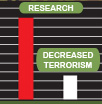
Military Solution to Afghanistan Improbable
By Maj. Gen. (Ret.) Kulwant Singh, Col. Brian Rees, and Dr. David Leffler
In congressional testimony, Army Lt. Gen. Stanley McChrystal vowed that he would use a “holistic” strategy and take extreme measures to avoid Afghan civilian casualties. Its “measure of effectiveness will not be the number of enemy killed, it will be the number of Afghans shielded from violence,” he said.
By starting to think holistically and measuring the effectiveness of avoiding casualties, McChrystal is on the right track. However, his new strategy may not be sufficient to bring an end to the protracted violence. War is based in social stress that is not likely to be ended by changing the rules of engagement, limiting airstrikes or using small ground units in search and detention operations.
Although a military solution to the Afghanistan war is improbable, it is possible to deploy a scientifically verified technology of defense to reduce societal stress and end the war. Extensive research has confirmed its effectiveness, and militaries have already applied it in order to defuse and eliminate conflict and prevent disruption and attack from within the country or outside the country.
Meditation has been shown to reduce stress not only in the individual but also throughout society. The Vedic tradition of knowledge, from ancient India, includes highly developed, non-religious meditation practices-in particular the Transcendental Meditation program and its advanced techniques-that have become the focus of intense scientific research over the past 50 years. These practices, taken together, are known as Invincible Defense Technology (IDT) in military circles. They have been used by members of many faiths to eliminate conflict in the recent past. If the military were to apply this human resource-based technology, which is non-lethal and non-destructive, it could reduce the collective societal stress fueling the tensions in Afghanistan.
A Prevention Wing of the Military would be the ideal way to achieve this goal. It would comprise about 2 to 3 percent of the military of Afghanistan. The personnel involved would practice these technologies in large groups, morning and evening. Studies show that when the size of the IDT group reaches a particular threshold, war and terrorism abate, crime goes down in the affected population, and quality-of-life indices go up.
Scientists have named this phenomenon the Maharishi Effect after Maharishi Mahesh Yogi, who first predicted it. In 1993, a two-month Maharishi Effect intervention was studied in Washington, DC. Predictions of specific drops in crime and other indices were lodged in advance with government leaders and newspapers. The research protocol was approved by an independent Project Review Board. The findings, published in Social Indicators Research, showed that crime fell 23 percent below the predicted level when the IDT group reached its maximum. Temperature, weekend effects, and previous trends in the data failed to account for changes.
Over 50 studies have evaluated and confirmed the reduction of crime, violence, terrorism, and even open warfare through the establishment of IDT groups. The causal mechanism has been postulated to be a field effect of consciousness-a spillover effect on the level of the unified field from the peace-creating group into the larger population. A study published in the Journal of Social Behavior and Personality offers an explanation of a proposed causality of IDT in biological terms. Research on the powerful neurotransmitter serotonin has shown that it produces feelings of contentment, happiness and even euphoria. Low levels of serotonin correlate with violence, aggression, and poor emotional moods. The peer-reviewed study showed that higher numbers of IDT experts practicing in groups correlated with an increase in serotonin production among other community members. These results were statistically significant and followed the attendance figures in the IDT group. This finding offers a plausible neurophysiologic mechanism to explain reduced aggression and hostility in society at large.
The Maharishi Effect has also been documented on a global scale in a study published in the Journal of Offender Rehabilitation. When large assemblies of IDT experts exceeded the Maharishi Effect threshold for the world (about 7,000 at that time) during the years 1983-1985, terrorism globally decreased 72%, international conflict decreased 32%, and violence was reduced in other nations without intrusion by other governments. This study used data provided by the Rand Corporation.
The evidence indicates that the military may be able to accomplish its mission simply by establishing a coherence-creating unit of IDT experts. As part of its responsibility to protect, the military is obligated to thoroughly examine methods for preventing war and terrorism. IDT is such a method. All that is necessary is to provide the proper training for a group of military personnel- or indeed, any large group within the country. Lt. Gen. McChrystal has the opportunity today to implement a cost-effective, scientifically validated and truly holistic strategy to bring peace to Afghanistan.
Events on the ground in Afghanistan and Pakistan may increase the difficulty of exploiting this opportunity in the future.










